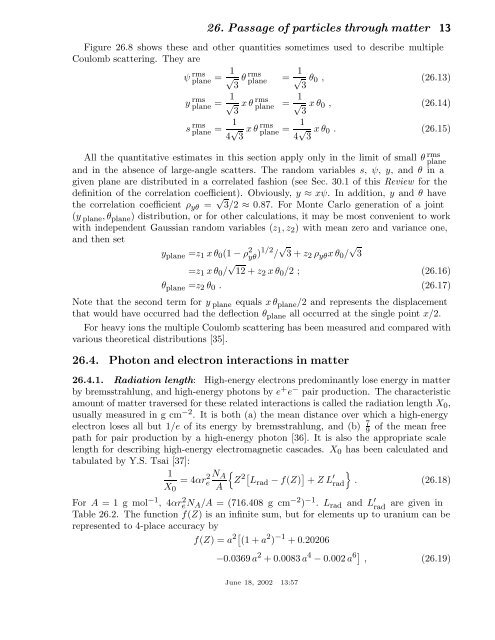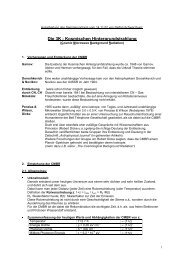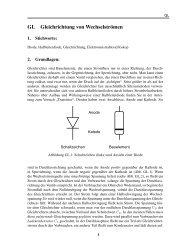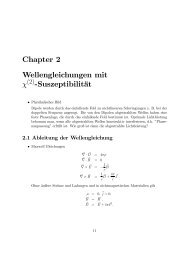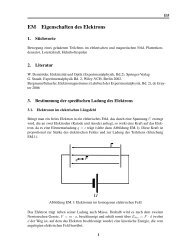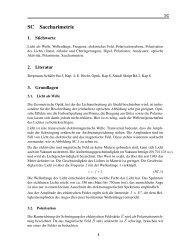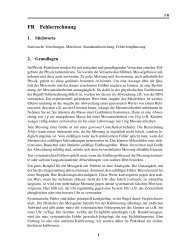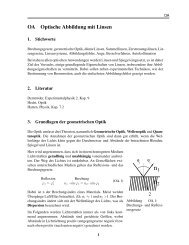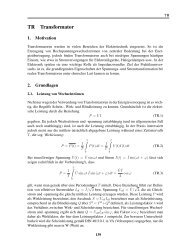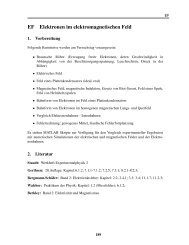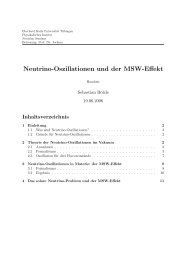26. passage of particles through matter - Particle Data Group
26. passage of particles through matter - Particle Data Group
26. passage of particles through matter - Particle Data Group
You also want an ePaper? Increase the reach of your titles
YUMPU automatically turns print PDFs into web optimized ePapers that Google loves.
<strong>26.</strong> Passage <strong>of</strong> <strong>particles</strong> <strong>through</strong> <strong>matter</strong> 13<br />
Figure <strong>26.</strong>8 shows these and other quantities sometimes used to describe multiple<br />
Coulomb scattering. They are<br />
ψ rms<br />
plane = √ 1 θ rms<br />
3<br />
plane = √ 1 θ 0 , (<strong>26.</strong>13)<br />
3<br />
y rms<br />
plane =<br />
1 √<br />
3<br />
xθ rms<br />
plane = 1 √<br />
3<br />
xθ 0 , (<strong>26.</strong>14)<br />
s plane rms = 1<br />
4 √ 3 xθrms plane = 1<br />
4 √ 3 xθ 0 . (<strong>26.</strong>15)<br />
All the quantitative estimates in this section apply only in the limit <strong>of</strong> small θ rms<br />
plane<br />
and in the absence <strong>of</strong> large-angle scatters. The random variables s, ψ, y, andθin a<br />
given plane are distributed in a correlated fashion (see Sec. 30.1 <strong>of</strong> this Review for the<br />
definition <strong>of</strong> the correlation coefficient). Obviously, y ≈ xψ. In addition, y and θ have<br />
the correlation coefficient ρ yθ = √ 3/2 ≈ 0.87. For Monte Carlo generation <strong>of</strong> a joint<br />
(y plane ,θ plane ) distribution, or for other calculations, it may be most convenient to work<br />
with independent Gaussian random variables (z 1 ,z 2 ) with mean zero and variance one,<br />
andthenset<br />
y plane =z 1 xθ 0 (1 − ρ 2 yθ )1/2 / √ 3+z 2 ρ yθ xθ 0 / √ 3<br />
=z 1 xθ 0 / √ 12 + z 2 xθ 0 /2; (<strong>26.</strong>16)<br />
θ plane =z 2 θ 0 . (<strong>26.</strong>17)<br />
Note that the second term for y plane equals xθ plane /2 and represents the displacement<br />
that would have occurred had the deflection θ plane all occurred at the single point x/2.<br />
For heavy ions the multiple Coulomb scattering has been measured and compared with<br />
various theoretical distributions [35].<br />
<strong>26.</strong>4. Photon and electron interactions in <strong>matter</strong><br />
<strong>26.</strong>4.1. Radiation length: High-energy electrons predominantly lose energy in <strong>matter</strong><br />
by bremsstrahlung, and high-energy photons by e + e − pair production. The characteristic<br />
amount <strong>of</strong> <strong>matter</strong> traversed for these related interactions is called the radiation length X 0 ,<br />
usually measured in g cm −2 . It is both (a) the mean distance over which a high-energy<br />
electron loses all but 1/e <strong>of</strong> its energy by bremsstrahlung, and (b) 7 9<br />
<strong>of</strong> the mean free<br />
path for pair production by a high-energy photon [36]. It is also the appropriate scale<br />
length for describing high-energy electromagnetic cascades. X 0 has been calculated and<br />
tabulated by Y.S. Tsai [37]:<br />
1<br />
X 0<br />
=4αr 2 e<br />
N<br />
{ A<br />
Z 2[ L<br />
A rad − f(Z) ] }<br />
+ ZL ′ rad . (<strong>26.</strong>18)<br />
For A =1gmol −1 , 4αre 2N A/A = (716.408 g cm −2 ) −1 . L rad and L ′ rad<br />
are given in<br />
Table <strong>26.</strong>2. The function f(Z) is an infinite sum, but for elements up to uranium can be<br />
represented to 4-place accuracy by<br />
f(Z) =a 2[ (1 + a 2 ) −1 +0.20206<br />
−0.0369 a 2 +0.0083 a 4 − 0.002 a 6] , (<strong>26.</strong>19)<br />
June 18, 2002 13:57


